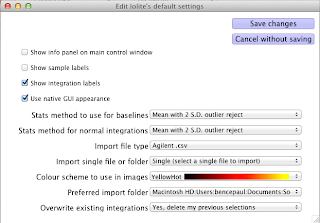There are plenty of ways to customise Iolite. We're going to break them up into three main categories: basics, viewing, and DRS specific. So let's start with the basics.
If you haven't already noticed, in the Iolite menu at the top, there's an item called "Modify Iolite's default settings". Selecting this item opens a panel showing the basic settings that you can change. Note that any changes you make here will usually take effect for the next experiment you start, not the current one.
Lets go through what each of these mean.
Show info panel on main control window: If this option is checked, a small info panel will appear at the bottom of the Main Control Window. This panel shows information about any cursors currently placed in the window. By default, you won't have any cursors in the window, so this is usually left unchecked.
Show sample labels: Checking this option will show the filename from which the data was loaded at the first point of the data. This will be printed in blue and be vertically aligned. This is the same as checking the box in top left of the Main Control Window, and chooses whether this box is checked by default.
Show integration labels: Each integration can have its own "annotation" or label. This can be entered manually or automatically if you have a laser log file or use one of the other automatic integration methods. Checking this box makes these labels appear by default.
Use native GUI appearance: Igor Pro allows programmers to set whether the buttons and other user interface items, like drop-down menus etc, will take the default Igor appears (rather square looking with flat colours) or use the system OS appearance. For example, if you're using Igor Pro on a Mac running OS 10.7, the buttons will appear more 3D and have rounded corners etc. This option may sound rather aesthetic but if you're experiencing slow performance while using Iolite, try unchecking this option.
Stats method to use for baselines: You can select the default outlier rejection to be used for calculating mean of each baseline integration using this option. Open the drop-down menu to see all of the choices. The default is currently "mean with 2 S.D. outlier reject" but as this will reject the outside ~3% of points even if they're normally distributed, I would suggest setting the default to "mean with 3 S.D. outlier reject". Remember, this the default that will be used when you start a new experiment. You can change the stats method for individual experiments by clicking on the "Edit Settings" button in the Main Control Window.
Stats method for normal integrations: This is the same as for baselines but will select the method for all other integration types, i.e. reference materials and unknowns.
Import file type: Use this option to select the file type you most often import. For example, if you mostly reduce Agilent data using Iolite, set this option to Agilent.csv. For all new experiments, Agilent.csv will be the default file type in the import options window that appears when you click the Import Data button.
Import single file or folder: Similar to the above option, this selects whether you want to open individual files, or entire folders, by default.
Colour scheme to use in images: when you first create an image, Iolite will look for your default colour scheme and use that to colour your images. You can set this default colour scheme here.
Preferred import folder: Use this option to select the folder you most often import files from. For example, if you have a folder you store all your raw data in called "My Mass Spec Data", use this option to select that folder and when you next import data, Iolite will automatically go to your "My Mass Spec Data" folder to allow you to select your raw data file.
Overwrite existing integrations: This option comes into play when you use one of the automatic integrations methods, such as a laser log file. If you have already selected integrations in an integration type (e.g. G_NIST612), when you try to automatically add integrations to the same integration type, Iolite asks you whether you want to delete the existing integrations and replace them with the new ones you've just defined, or whether you want to keep them and add the new ones as well. If you're adding a lot of integrations automatically, you can be asked this question quite a few times, so use this option to set whichever you'd like to be the default action. You will still be asked to confirm, but your preferred option will be the default.
This is how to change some of the basic settings in Iolite. In the next blog post, we'll show you how to set the Traces Window up so that it shows your favourite channels, with your preferred zoom settings too.
If you have any suggestions for default settings that you wish you could change, please let us know in the comments, or feel free to start a new topic on the forum.
The Iolite Team

No comments:
Post a Comment